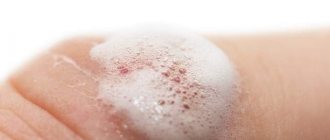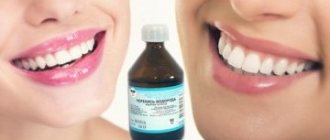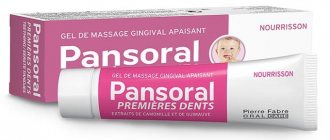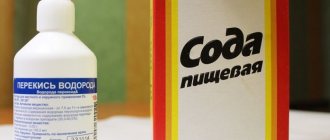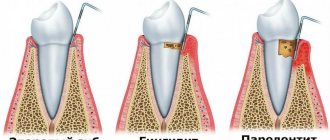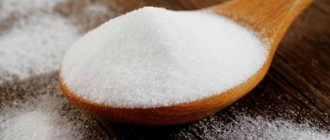27.11.2019
In addition to specially developed drugs for the treatment of inflammatory gum diseases, products that are available in every home can be used. For example, hydrogen peroxide helps eliminate the inflammatory process, improve blood supply to the gums, and stimulate the consumption of oxygen by cells.
Properties
Hydrogen peroxide is used as an antimicrobial agent for treating wounds. Treatment of gums with hydrogen peroxide eliminates pathogenic microflora and cleans teeth from plaque.
The product is used not only as a rinse, but also for oral administration. Once in the body, it breaks down into water and oxygen, which stimulates blood circulation. Also, its use allows you to get rid of fungi and viruses. Hydrogen peroxide can be successfully used to treat periodontal disease. However, you should be extremely careful about the dosage of the drug.
Important! In addition to its effect on the gums, the use of hydrogen peroxide can also reduce the risk of developing caries. The cause of caries is bacteria, and in particular, staphylococcus, which can be gotten rid of by rinsing.
The proliferation of bacteria in the oral cavity leads to damage to soft tissues and gums. As a result, many complications can develop, such as stomatitis. It is accompanied by the formation of ulcers that do not heal for a long time. This is accompanied by a deterioration in the person’s general condition: weakness appears, the temperature rises, and other symptoms of intoxication are observed.
This can all be prevented by preventing bacterial growth by rinsing with peroxide. Bad breath is also a common problem. Rinsing will also help deal with it. Hydrogen peroxide can treat diseases such as:
- gingivitis;
- chronic periodontitis;
- periodontal disease;
- stomatitis, etc.
However, efficiency is not the only advantage of this product. It is very convenient that it is widespread and it is not difficult to find it in any pharmacy. In addition, the low price makes it accessible to everyone who wants to take care of their teeth.
Teeth whitening at home with peroxide: caution is necessary!
Having chosen hydrogen peroxide as a home whitening product, you need to be extremely careful when using this substance:
- Do not swallow under any circumstances; if this happens accidentally, consult a doctor immediately.
- This substance should not be used by pregnant women and children under twelve years of age;
- stop the procedure if there is a feeling of discomfort or redness of the mucous membranes is observed;
- It is not recommended to whiten teeth with peroxide for people with deep wounds or mouth ulcers, as well as for those who have recently had their tongue pierced;
- choose exclusively 3% peroxide for whitening, do not use stronger concentrates;
- Those who have intestinal or stomach diseases should also avoid peroxide;
- check the body's reaction to peroxide before starting bleaching (apply the substance to the back of the hand for a while);
- This type of whitening is not recommended for those who have plates or braces in their mouth;
- do not use large amounts of peroxide, so as not to damage the integrity of the enamel;
- do not keep the product in your mouth for more than a few seconds;
- take breaks between whitening courses;
- There is no need to whiten teeth with peroxide for people with caries, increased sensitivity of enamel and bleeding gums;
- Regardless of the chosen method of whitening, after using peroxide, be sure to rinse your mouth thoroughly;
- eat no earlier than half an hour after the procedure.
In order for whitening to be effective and as safe as possible, you should use only fresh peroxide, which is stored in an airtight jar. In addition, you need to understand that hydrogen peroxide will only help if your teeth have darkened as a result of any external factors. If the yellowness of teeth is hereditary or was acquired while taking antibiotics, then peroxide is powerless.
Try ASEPTA PLUS Gentle whitening paste - it effectively fights plaque and deposits, gently whitens, returning teeth to their natural color. The effect is noticeable after the first 2-3 cleanings.
Ingestion
A peroxide solution is used for oral administration. To prepare it, mix 1 drop of the product with 50 ml of warm water. During the course of treatment, the dosage is increased by adding one drop every day, bringing their number to 10.
The solution should be taken 30 minutes before meals, or 2 hours after. The course of treatment involves taking the drug 3 times a day for 10 days. After this time, take a break for 3 days, and then repeat it all over again.
When treated with hydrogen peroxide, side effects may occur, such as skin reactions, indigestion, nausea. If the listed symptoms do not go away after a few days, further treatment should be abandoned.
Important! Under no circumstances should hydrogen peroxide be taken undiluted, nor should the dosage be exceeded.
Features of the use of hydrogen peroxide in dentistry
Hydrogen peroxide is an antiseptic solution based on 3% hydrogen peroxide. It has a powerful disinfectant and antibacterial effect and quickly stops bleeding. Due to these properties, peroxide is widely used in dental practice. In particular, hydrogen peroxide is used to treat the mucous membranes of the oral cavity for periodontitis, gingivitis, stomatitis, to disinfect the edges of the socket after tooth extraction, and to treat ulcers. The product is also used in the procedure for whitening tooth enamel, removing pigment spots and plaque from it. Peroxide is the main component of whitening gels and pastes.
Contraindications
Hydrogen peroxide has few contraindications for use. The most important thing is to use the mouth rinse correctly. But there are people who are not recommended to use the product even in this form.
The list includes:
- persons with hypersensitivity to the components of the drug;
- children under 12 years of age;
- persons whose illness has taken an acute form (during relapse);
- patients using antibacterial drugs.
Pregnant women and nursing mothers are not at risk, but are advised to consult with their doctor before using hydrogen peroxide for bad breath.
What is this substance?
Hydrogen peroxide is a combination of two oxygen molecules and two hydrogen molecules; it is colorless and odorless. The substance is very unstable and quickly disintegrates upon contact with pathogenic flora.
Reference! When hydrogen peroxide breaks down, molecular oxygen is formed; it has an oxidizing property, which is why it is used in medicine as a disinfectant.
Hydrogen peroxide is used only externally; internal use is not practiced . More than a hundred years ago, medical scientists found that rinsing the mouth with hydrogen peroxide is absolutely harmless. At that time, diphtheria and stomatitis were treated with this substance.
Hydrogen peroxide comes in different forms:
- Solution – 3%.
- Concentrated solution – perhydrol – up to 31%.
- Hydroperite – 35%. Available in tablets.
To rinse the mouth, you can use a 3% solution and hydroperite after dissolving it in water to the desired concentration. Perhydrol is used in pharmacology, as well as for disinfection of premises.
Dental diseases
The effectiveness of hydrogen peroxide has been tested for more than one generation. It has been proven to help cope with many dental diseases. It also has the accompanying property of helping to whiten tooth enamel. By the way, many home teeth whitening products contain hydrogen peroxide. It is useful to rinse your mouth to prevent dental problems. This is an excellent product for additional oral hygiene, as well as an excellent preventative against caries. And using hydrogen peroxide along with baking soda will help whiten your teeth even more effectively.
But it should be remembered that the effect of peroxide is extremely powerful. This means that you cannot use this remedy as you please. Even a small concentration of it will help achieve a positive effect for teeth, gums and the oral cavity as a whole.
Current methods of caries treatment
In traditional dental practice, treatment with hydrogen peroxide is not used. In addition, hydrogen peroxide, despite its pronounced antiseptic effect, cannot restore damaged tooth tissue or compensate for the lack of minerals in tooth enamel. Therefore, if you have symptoms of caries, you should not self-medicate. Seek help from a good dental clinic.
Today, caries is treated in two main ways - conservative or surgical. Conservative methods are non-invasive, that is, treatment is carried out without preparing the tooth.
- Remineralization of enamel.
The tooth is coated with compounds that contain phosphorus and calcium ions, the main mineral substances of tooth enamel.
- Fluoridation.
Fluoride-containing gels, varnishes, and pastes are applied to the surface of the teeth, which ensure saturation of the enamel with fluorides. They strengthen the surface of the teeth, increase the resistance of the enamel to the action of bacteria, and protect the teeth from calcium losses.
- ICON method.
Another minimally invasive method of treating carious lesions, which is carried out without drilling or filling the tooth. The dentist alternately applies several compounds to the surface of the tooth, the last of which seals the pores of the tooth enamel. This sealing protects teeth from the penetration of bacteria into deep tissues and prevents the development of caries.
These methods do not cause pain to the patient, so they can be performed without anesthesia. But they give an effective result only if the carious process is at the initial stage and there is no carious cavity in the tooth yet.
If there is a hole in the tooth, caries is treated surgically:
- Cleans enamel from plaque and tartar.
- An anesthetic injection is given if treatment for medium or deep caries is considered.
- The cavity is drilled out and all affected and dead tissue is carefully removed.
- The cavity is disinfected with antiseptics and its walls are coated with an adhesive composition, which will allow the filling to adhere better.
- An insulating or therapeutic pad is placed at the bottom of the cavity to protect the pulp or relieve inflammation.
- The tooth is filled with a suitable material and given its natural shape.
- Grinding and polishing are carried out to align the tooth with the bite and form a smooth, even surface.
A correctly selected treatment method helps to cope with caries at any stage, stop the development of the pathological process, and return the tooth to its natural appearance.
How to properly prepare the solution and rinse your mouth
Before you rinse your mouth with hydrogen peroxide, you need to dilute it. It is recommended to take a tablespoon of hydrogen peroxide per glass of water. The solution should not be hot, but not cold either. Rinsing begins only after thoroughly brushing your teeth and rinsing the mouth with clean water; such manipulations will prevent unwanted chemical reactions between the components of the drug and the toothpaste.
The peroxide solution should not be kept in the mouth for too long; it is recommended to carry out the procedure for no longer than 10 minutes. During this time, you should periodically spit out the liquid and put a fresh portion into your mouth. After the procedure is completed, the product is spat out so that it does not remain in the mouth or enter the digestive system.
If the rules of rinsing are violated, nausea and vomiting may occur; in severe cases, burns of the digestive organs may occur. If you feel a strong burning sensation during the procedure, especially if there are ulcers on the oral mucosa, you should stop rinsing and rinse your mouth with clean water.
Side effects and contraindications
The use of hydrogen peroxide undoubtedly benefits both the gums and the body. But like any medicine, it is not without side effects. The main side effects include:
- Destruction of normal oral microbiota.
- Violation of acid-base balance.
- Burns to the oral cavity due to improper preparation of the solution.
- Destruction of enamel and gum tissue.
- Burns of the esophagus when swallowing the solution.
- Metallic taste in the mouth, nausea, vomiting.
- Allergic reactions.
A properly prepared solution in compliance with the rinsing proportions and the correct use of peroxide reduces side effects to a minimum. Before use, you should pay attention to the presence of contraindications, which include:
- Enamel hypersensitivity.
- Thinning of the enamel of congenital or acquired origin.
- Advanced caries and filled teeth.
- Hypersensitivity to the product or components of the prepared solutions.
- Age less than 12 years.
- Chronic diseases in the acute stage.
- Other diseases in the acute period.
- Taking a course of antibiotics.
Although hydrogen peroxide is not a specific medicine for the treatment of dental diseases, it definitely works. If any disease occurs, you do not need to immediately rinse your mouth, but should consult a dentist in order to understand the pathology and receive adequate therapy.
Bibliography
- Barer G.M. – Periodontal diseases. Textbook, M.: GEOTAR-Media, 2008.
- Dmitrieva L.A. — Modern aspects of clinical periodontology, M., 2001.
- Shumsky L.V., Grebnev E.N., Yurchenko E.V. — Herpetic infection of the oral cavity and lips, Samara, 1996.
- Borovsky E.V. and co-authors - Therapeutic dentistry, M. 1998.
- Vertkin A.L. – Clinical pharmacology for students of dental faculties, M.: GEOTAR-Media, 2007.
Find a clinic
If there is a disease of the mucous membranes or gums
It is advisable to use hydrogen peroxide for the following diseases of the gums or oral mucosa:
- Chronic periodontitis.
- Periodontal disease.
- Stomatitis.
- Gingivitis, etc.
But it is better to consult a dentist about its use. Hydrogen peroxide, of course, can fight infection due to its disinfecting effect. But the main thing is to do no harm. If you are in doubt about its use or you do not like its taste. You can safely replace it with regular baking soda.
It is the ability to kill bacteria and microbes that helps peroxide cope with the most difficult infection that settles on the mucous membrane of the mouth and gums.
How to properly prepare a rinse solution
It is important to follow the technique for preparing the solution, because if the concentration of the active substance is low, there will be no therapeutic effect. If the recommended concentration is exceeded, complications such as burns and destruction of enamel and gums are possible. There are two ways to prepare the solution. In the first case, use 1 tablespoon of 3% peroxide per 200 ml of water. In the second, 1 tablet of “Hydroperit” should be diluted with 200 ml of water.
Stomatitis
Rinsing in the treatment of stomatitis is aimed at destroying pathogenic microorganisms from the mucous membrane. You need to rinse your gums and teeth with the prepared solution for 1 minute, 1 to 3 times in a row, while changing the solution. After the procedure, it is necessary to irrigate the oral cavity with water. 3-4 manipulations per day. It is effective to wipe the affected areas with a cotton swab dipped in undiluted peroxide, but after rinsing.
Periodontal disease
With periodontal disease, periodontal tissues are damaged with their atrophy and dystrophy. The roots of the tooth are exposed, which is expressed in complaints of receding gums, toothache and pain. It is recommended to rinse the mouth with diluted peroxide for 10 minutes, periodically changing the solution. Repeat the procedure 4 times a day.
Eliminating bad breath
Halitosis or “bad breath” is a symptom of dental diseases such as periodontal disease and periodontitis, as well as a marker of digestive system diseases.
Gargling with hydrogen peroxide helps eliminate odor if the cause is located in the mouth.
The procedure is carried out according to the method described above, using a previously prepared solution.
Teeth whitening
A number of methods for teeth whitening have been described.
- Prepare a mixture of peroxide and baking soda, apply the resulting mixture to a toothbrush and brush your teeth. After the procedure, rinse the mouth with water and limit food intake for 30 minutes.
- 3 drops of pharmaceutical preparation are added to the toothpaste.
- To eliminate a single stain on the enamel, you can clean it with a cotton swab soaked in peroxide.
